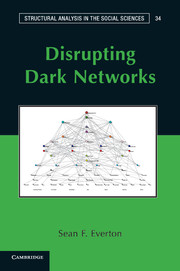Book contents
- Frontmatter
- Contents
- Figures
- Tables
- Preface
- Acknowledgments
- Part I Introduction
- Part II Social Network Analysis: Techniques
- 3 Getting Started with UCINET, NetDraw, Pajek, and ORA
- 4 Gathering, Recording, and Manipulating Social Networks
- Part III Social Network Analysis: Metrics
- Part IV Social Network Analysis: Advances
- Part V Conclusion
- Appendix 1 The Noordin Top Terrorist Network
- Appendix 2 Glossary of Terms
- Appendix 3 Multidimensional Scaling with UCINET
- Appendix 4 The Just War Tradition
- References
- Index
4 - Gathering, Recording, and Manipulating Social Networks
Published online by Cambridge University Press: 05 April 2013
- Frontmatter
- Contents
- Figures
- Tables
- Preface
- Acknowledgments
- Part I Introduction
- Part II Social Network Analysis: Techniques
- 3 Getting Started with UCINET, NetDraw, Pajek, and ORA
- 4 Gathering, Recording, and Manipulating Social Networks
- Part III Social Network Analysis: Metrics
- Part IV Social Network Analysis: Advances
- Part V Conclusion
- Appendix 1 The Noordin Top Terrorist Network
- Appendix 2 Glossary of Terms
- Appendix 3 Multidimensional Scaling with UCINET
- Appendix 4 The Just War Tradition
- References
- Index
Summary
Introduction
Social network analysis software packages such as UCINET, NetDraw, Pajek, and ORA often come with ready-to-use data. In the real world, however, we have to collect and record it on our own. Knowing how to do this is an important first step in SNA. We can gather and prepare social network data in a variety of ways, but most social network analysts record social network data in matrix form. For small datasets it usually makes sense to enter the data directly into UCINET or ORA, using their internal spreadsheet functions. When working with large networks, however, it is generally preferable to initially enter social network data into a standard spreadsheet program, such as Microsoft Excel, and then import (or paste) it into UCINET, NetDraw, Pajek, or ORA. One of Excel's attractions is its “auto-complete” feature that compares the text you are typing into a cell with text already entered into the same column, which increases accuracy (e.g., consistently spelling the same name the same way each time) and input time.
This chapter focuses on collecting, recording, and manipulating network data. Before turning to the nuts and bolts of how to do this, however, we need to first consider how social network analysts specify a network's boundaries, the difference between personal (ego) and complete networks, the various types of social network data, and the variety of ways that researchers collect social network data. Only then will we be ready to collect, record, and manipulate actual social network data.
Information
- Type
- Chapter
- Information
- Disrupting Dark Networks , pp. 76 - 132Publisher: Cambridge University PressPrint publication year: 2012
